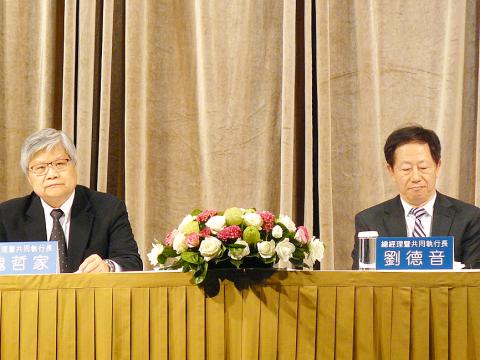Taiwan Semiconductor Manufacturing Co (TSMC, 台積電) yesterday again raised its capital spending to cope with stronger-than-expected mobile phone demand.
The company plans to spend between US$9.5 billion and US$10.5 billion this year, up about 5 percent from April’s estimate of between US$9 billion and US$10 billion.
The capital spending increase will be “mainly for 10-nanometer [nm] and 7nm [technologies],” TSMC chief financial officer Lora Ho (何麗梅) told investors. “We see a stronger mobile [chip] demand than we expected. We need to build more capacity next year.”

Photo: CNA
TSMC plans to ramp up production of 10nm technology in the first quarter next year and 7nm in 2018.
The company expects to grab more than a 70 percent share of the 10nm segment worldwide next year, Ho said.
“Apple Inc and Mediatek Inc (聯發科) will be early adopters [of TSMC’s 10nm technology] in the first half of 2017,” BNP Paribas SA analyst Laura Chen (陳佳儀) said in a report on Wednesday.
“We believe TSMC will sustain its leading position globally in 10nm and 7nm and onward,” Chen said.
TSMC co-chief executive officer Mark Liu (劉德音) yesterday predicted that the company’s revenue would expand at a compound annual growth rate of between 5 and 10 percent in the next five years, outpacing expected growth in the global semiconductor industry of 2 or 3 percent.
The company said the smartphone segment would be one of its major growth drivers going forward, despite smartphone growth having slowed over the past six quarters, Liu said.
Liu said he expects TSMC’s smartphone chip revenue contribution to move higher than the current 55 percent in the next five years.
For this quarter, TSMC expects revenue to increase by as much as 15.86 percent to NT$257 billion (US$8.01 billion) from last quarter’s NT$221.81 billion.
Ho attributed the growth to customers’ new product launches and persistent inventory buildup, primarily for Android-based phones.
Gross margin is expected to stand at between 50 and 52 percent this quarter, compared with last quarter’s 51.5 percent, while operating margin could be between 39.5 percent and 41.5 percent, following last quarter’s 41.2 percent, Ho said.
In the April-to-June quarter, TSMC reported a record profit of NT$72.51 billion, up 11.9 percent from NT$64.76 billion in the previous quarter and beating Daiwa Capital Markets’ estimate of NT$68.42 billion and NT$66.3 billion predicted by BNP Paribas.
However, last quarter’s profit fell 8.7 percent year-on-year.
Earnings per share were NT$2.8 in the second quarter, compared with NT$2.5 in the first quarter and NT$3.06 in the same period last year.
In the second quarter, chips made using 16nm or 20nm technology accounted for 23 percent of TSMC’s total revenue, while chips made using 28nm technology made up 28 percent, the company said.
TSMC shares were unchanged at NT$168.5 yesterday.

The US dollar was trading at NT$29.7 at 10am today on the Taipei Foreign Exchange, as the New Taiwan dollar gained NT$1.364 from the previous close last week. The NT dollar continued to rise today, after surging 3.07 percent on Friday. After opening at NT$30.91, the NT dollar gained more than NT$1 in just 15 minutes, briefly passing the NT$30 mark. Before the US Department of the Treasury's semi-annual currency report came out, expectations that the NT dollar would keep rising were already building. The NT dollar on Friday closed at NT$31.064, up by NT$0.953 — a 3.07 percent single-day gain. Today,

‘SHORT TERM’: The local currency would likely remain strong in the near term, driven by anticipated US trade pressure, capital inflows and expectations of a US Fed rate cut The US dollar is expected to fall below NT$30 in the near term, as traders anticipate increased pressure from Washington for Taiwan to allow the New Taiwan dollar to appreciate, Cathay United Bank (國泰世華銀行) chief economist Lin Chi-chao (林啟超) said. Following a sharp drop in the greenback against the NT dollar on Friday, Lin told the Central News Agency that the local currency is likely to remain strong in the short term, driven in part by market psychology surrounding anticipated US policy pressure. On Friday, the US dollar fell NT$0.953, or 3.07 percent, closing at NT$31.064 — its lowest level since Jan.

The New Taiwan dollar and Taiwanese stocks surged on signs that trade tensions between the world’s top two economies might start easing and as US tech earnings boosted the outlook of the nation’s semiconductor exports. The NT dollar strengthened as much as 3.8 percent versus the US dollar to 30.815, the biggest intraday gain since January 2011, closing at NT$31.064. The benchmark TAIEX jumped 2.73 percent to outperform the region’s equity gauges. Outlook for global trade improved after China said it is assessing possible trade talks with the US, providing a boost for the nation’s currency and shares. As the NT dollar

The Financial Supervisory Commission (FSC) yesterday met with some of the nation’s largest insurance companies as a skyrocketing New Taiwan dollar piles pressure on their hundreds of billions of dollars in US bond investments. The commission has asked some life insurance firms, among the biggest Asian holders of US debt, to discuss how the rapidly strengthening NT dollar has impacted their operations, people familiar with the matter said. The meeting took place as the NT dollar jumped as much as 5 percent yesterday, its biggest intraday gain in more than three decades. The local currency surged as exporters rushed to